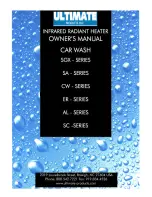
WATER SUPPLIES
10
CAUTION
If the water supply has a TDS greater than 150 mg/L and a green anode has not been changed to a black
anode, or if the TDS is greater than 600 mg/L and the anode has not been changed to a blue anode, there is
the possibility the anode may become overactive and hydrogen gas could accumulate in the top of the water
heater during long periods of no use. In areas where this is likely to occur, the installer should instruct the
householder on how to dissipate the gas safely.
If, under these conditions, the water heater has not been used for two or more weeks the following procedure
should be carried out before using any electrical appliances (automatic washing machines and dishwashers)
which are connected to the hot water supply.
The hydrogen, which is highly flammable, should be vented safely by opening a hot tap and allowing the
water to flow. There should be no smoking or naked flame near the tap whilst it is turned on. Any hydrogen
gas will be dissipated. This is indicated by an unusual spurting of the water from the tap. Once the water runs
freely again, any hydrogen in the system will have been released.
SATURATION INDEX
The saturation index (SI) is u
sed as a measure of the water‟s corrosive or scaling properties.
In a corrosive water supply, the water can attack copper parts and cause them to fail. Where the saturation
index is less than
–1.0, the water is very corrosive and warranty does not apply to a copper sheathed heating
unit. A corrosion resistant heating unit must be used. An expansion control valve may need to be fitted on
the cold water line after the non-return valve in a corrosive water area where there are sufficient quantities of
silica dissolved in the water.
In a scaling water supply calcium carbonate is deposited out of the water onto any hot metallic surface.
Where the saturation index exceeds +0.40, the water is very scaling. An expansion control valve must be
fitted on the cold water line after the non-return valve to protect and for warranty to apply to the temperature
pressure relief valve and water heater cylinder.
Where the saturation index e0.80, warranty does not apply to a standard watts density heating unit
or a heat pump heat exchanger. A low watts density heating unit must be used. Water with an SI greater
than +0.80 may be treated with a water softening device to reduce the SI of the water.
Contact your nearest Rheem Service Department or Accredited Service Agent if a replacement heating unit
is required.
Refer to the
cold water connection detail on page
31 for the position of the expansion control valve.
CHLORIDE AND PH
In a high chloride water supply, the water can corrode stainless steel parts and cause them to fail. Where the
chloride level exceeds 250 mg/L warranty does not apply to a
heat pump‟s stainless steel heat exchanger.
pH is used as a measure of t
he water‟s alkalinity and acidity. In an acidic water supply, the water can attack
stainless steel parts and cause them to fail. No warranty applies to a
heat pump‟s stainless steel heat
exchanger where the pH is less than 6.0. Water with a pH less than 6.0 may be treated to raise the pH.
The water supply from a rainwater tank in a metropolitan area is likely to be corrosive due to the dissolution
of atmospheric contaminants. This may result in pH of less than 6.0 and warranty would not apply to a heat
pum
p‟s stainless steel heat exchanger. It is recommended an analysis on the water from a rainwater tank be
conducted prior to connecting this type of water supply to a water heater with a stainless steel heat
exchanger.
CHANGE OF WATER SUPPLY
The changing or alternating from one water supply to another can have a detrimental effect on the operation
and / or life expectation of a water heater cylinder, a temperature pressure relief valve, a heating unit and a
heat exchanger in a heat pump water heater.
Where there is a changeover from one water supply to another, eg, a rainwater tank supply, desalinated
water supply, public reticulated water supply or water brought in from another supply, then water chemistry
information should be sought from the supplier or it should be tested to ensure the water supply meets the
requirements given in these guidelines for warranty to apply.











































